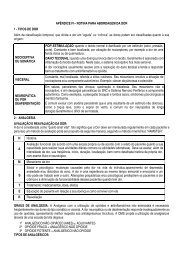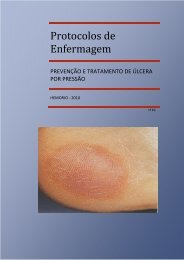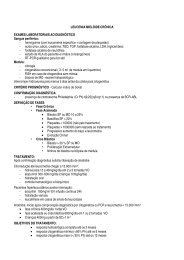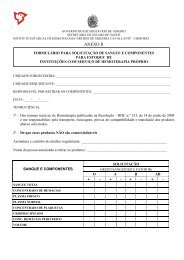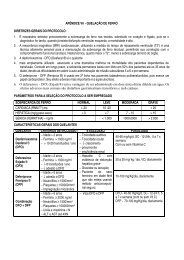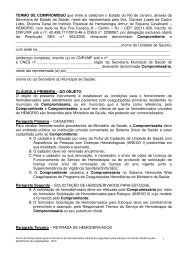Protocols - Hemorio
Protocols - Hemorio
Protocols - Hemorio
Create successful ePaper yourself
Turn your PDF publications into a flip-book with our unique Google optimized e-Paper software.
ATTACHMENT IV – PAIN APPROACH ROUTINE<br />
1 – KINDS OF PAIN<br />
In addition to the temporal classification, that divides the pain in “acute” or “chronic”, the pains may be<br />
classified regarding its origin:<br />
NOCICEPTIVE OR<br />
SOMATIC<br />
VISCERAL<br />
NEUROPATIC OR<br />
BY<br />
DEAFFERENTATION<br />
BY STIMULATION: when the normal tissue is damaged by stimulation (heat,<br />
pressure, cut). Constant and well located, by nociceptors activation; for instance,<br />
the pain of an incisive injury or burn;<br />
TISSUE DAMAGE: when a disease causes some damage to the tissue. It is<br />
usually associated to the damaged tissue inflammation. In this case, the<br />
nociceptive system is more sensible.<br />
The nociceptive pain usually resolves to the resolution of the tissue damage and<br />
tends to respond well to the treatment with anti-inflammatory and opioid.<br />
Constant, barely located, referred to skin sites. Its mechanism involves the<br />
activation of nociceptors and/or autonomic component. For instance: pancreas<br />
cancer and cholecystitis.<br />
In volley, paroxysms like shock, burning and dysesthesia. Its mechanism is not<br />
nociceptive, but paroxystic discharges of the CNS and Peripheral Nervous System<br />
and autonomic compound. As examples, the branchial plexopathy and lombus<br />
sacrum; post-surgical syndromes and ghost member.<br />
It is common to evolve with alodinia persistent, which is resultant from a not<br />
painful stimulation, such as a mild touch, as the blow of the wind, it is common at<br />
the long-term neuropathic pain. It is usually difficult to be treated.<br />
2 - ANALGESIA<br />
EVALUATION AND REEVALUATION OF THE PAIN:<br />
The pain is considered as the “fifth vital sign”. It means that the Pain must be regularly measured in each<br />
subject and, thus, an evaluation method may be proposed at the following way, following the mnemonic<br />
method “HAMSTER”.<br />
H History<br />
A<br />
Functional evaluation (in accordance to a proper scale or in accordance to the report of the<br />
subject regarding his capacity to perform his common daily activities or labor activities). You must<br />
evaluate, in addition to the intensity of the pain, its frequency, onset, length, location, as well as<br />
the detailed history of the pain itself, with a physical and neurological exam.<br />
M Mechanism of the pain<br />
Social and psychological: changes caused by the pain at the individual’s life, appearance of<br />
depression, anxiety and/or sleep disturbances. The pain is an experience both sensorial and<br />
S emotional, and one can not be treated without the other. Psychiatric and/or psychological changes<br />
predispose the subjects to the chronic pain and the decrease of the functionality of those subjects<br />
when they present the pain.<br />
T Treatment: drugs, dose, effects<br />
E Education of the subject in relation to his disease and how to live with it<br />
R Reevaluation<br />
198



